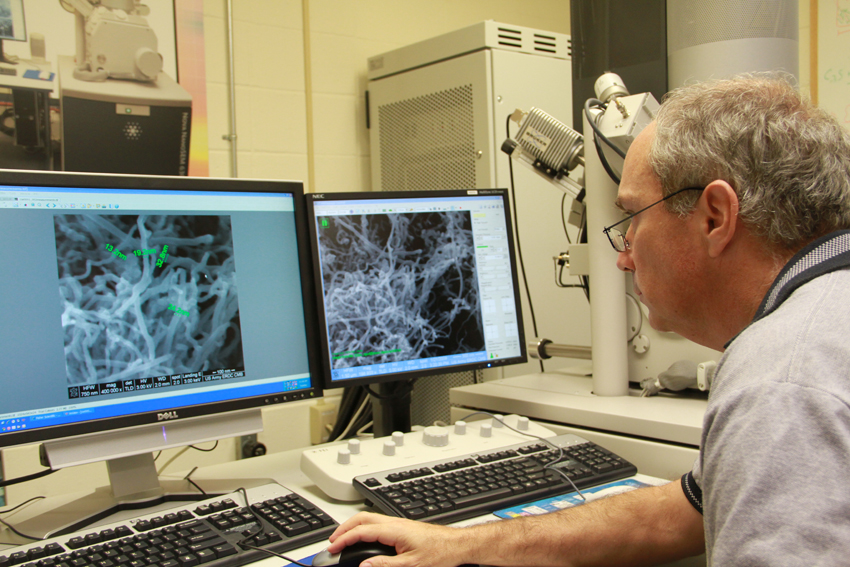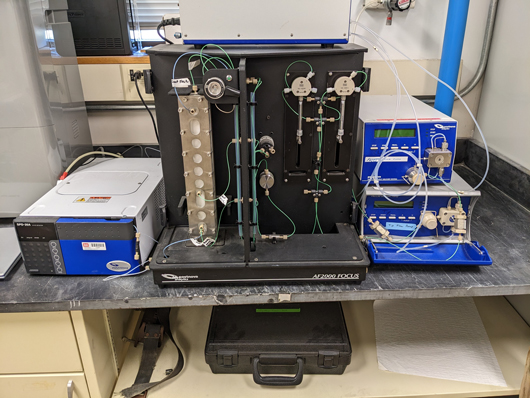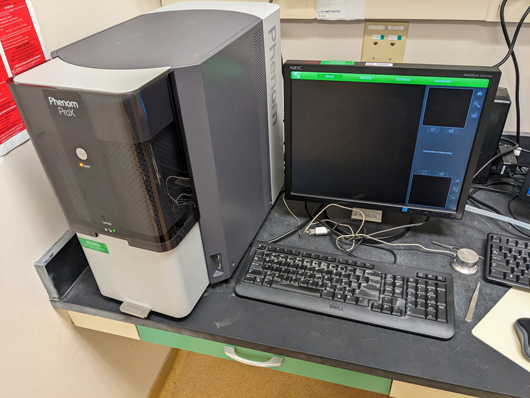Material Characterization
Due to their small size, nanoscale particles are very difficult to detect, characterize, and monitor in complex samples such as waste water, soil, and tissues. Since nanomaterial characteristics determined in pristine laboratory conditions will change when placed in complex environmental systems, it is critical to accurately determine size, composition, surface area, shape, quantity, and surface chemistry. Our cutting-edge characterization techniques used to analyze nanoscale particles are absolutely necessary for accurate quantitative environmental risk assessment.

ERDC's advanced NanoSEM Scanning Electron Microscope is used to determine size, shape, and elemental composition of nanoparticles in environmental samples.

The field flow fractionation technique is coupled to an inductively coupled mass spectrometer to separate particles by size followed by chemical analysis.

Laser Ablation interfaced to Inductively Coupled Plasma Mass Spectrometry.
Capabilities
- Atomic Force Microscope
- Bench top SEM
- Brunauer, Emmet and Teller Surface Area Analysis
- C-Therm Trident Thermal Conductivity
- Differential Scanning Calorimetry
- Dynamic Mechanical Analysis: TA Instruments RSA-G2 Solids Analyzer
- Energy Dispersive X-Ray Analysis
- Field Flow Fractionation interfaced to Inductively Coupled Plasma Mass Spectrometry
- Fourier Transform Infrared Spectrometer: Thermo Fisher Nicolet i50s
- Gel Permeation Chromatography
- Graphite Furnace Atomic Absorption Spectroscopy
- Inductively Coupled Plasma Mass Spectrometry with Dynamic Reaction Cell interference reduction capability
- Inductively Coupled Plasma Atomic Emission Spectroscopy
- Laser Light Scattering
- NanoNC eS robot electrospinner
- Particle Charge (Zeta potential)
- Physical Property Measurement System: Quantum Design Versalab
- Polymer impact tester (Tinius Olsen IT 503)
- Quartz Crystal Microbalance
- Raman Microscope
- Scanning Electron Microscope
- Shear Rheometer: TA Instruments Discovery Hybrid Rheometer 2
- Thermogravimetric Analysis
- Transmission Electron Microscope (TEM)
- Twin Screw Extruder (Thermo Fisher) with in-line injection molding capability
- X-Ray Diffraction (Malvern Panalytical Empyrean)
- X-ray Fluorescence Spectrometer(Malvern Epsilon 4)
Education
- Ph.D. Geochemistry, 2002; Colorado School of Mines; Golden, CO
- B.S. Chemistry, 1998; Arkansas State Universy; Jonesboro, AR
Research Interests
- Characterization of Rare Earth Element geochemistry
- Application of HPLC-ICP-MS speciation methods for geochemical characterization of metals
- Detection and characterization of nanomaterials
- Bioavailability, fate, and transport of metals, including nanomaterials
- Specialized analytical methods development
Anthony J. Bednar, PhD
Research Chemist
Education
- B.S.; Mississippi State University; Starkville, MS
Research Interests
- Materials Characterization
- Microscopy
- Petrographic Forensics
- Emerging Materials and Technologies
Kyle Klaus
Research Physical Scientist
Education
- M.S. Chemistry, 2016; University of Missouri; Columbia, MO
- B.S. Chemistry, 2013; College of the Ozarks; Point Lookout, MO
Research Interests
- Materials Characterization
- Microscopy
- Petrographic Forensics
- Emerging Materials and Technologies
Charles Laber
Education
- Ph.D. Chemistry; University of Mississippi; Oxford, MS
- B.S.; Wofford College; Spartanburg, SC
Research Interests
- Analytical chemistry, advanced chemical instrumentation to address challenging analytes and sample matrices
- Emerging environmental contaminants
- Developing analytical methods for insensitive munitions analysis
- Rare earth elements
Austin Scircle, PhD
Research Chemist
Education
- Ph.D. Chemistry, 1989; University of Illinois; Urbana-Champaign, IL
- M.S. Chemistry, 1987; University of Illinois; Urbana-Champaign, IL
- A.B. Geology and Computer Science (*Double Concentration), 1983; Colgate University; Hamilton, NY
Research Interests
- Materials Characterization
- X-ray Diffraction analyses of materials
- Microscopy
- Petrographic Forensics
- Emerging Materials and Technologies
Charles A. Weiss, Jr., PhD, RPG, FACI
Senior Research Geologist